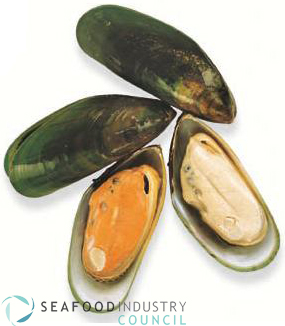GreenshellTM mussels (Perna canaliculus) are native to New Zealand.
While they grow “wild” in waters around the coast, it is farmed GreenshellTM mussels which are today firmly established as New Zealand’s largest seafood export.
The shellfish is recognisable by its emerald green shell markings. The flesh is full and plump, and richly flavoured. The flesh of the female is a soft-blush apricot colour, and the male a pale creamy colour.
GreenshellTM Mussel Industry
The industry developed on the exploitation of wild mussels, however there is no longer any commercial operation involving a wild fishery. As an aquaculture species, the government sets no limit on the volume of mussels extracted commercially.
Mussel Farming takes place in the Marlborough Sounds, along the Coromandel Peninsula, and in Stewart Island’s Big Glory Bay.
A mussel farm consists of a series of buoys held together by long lines attached to each side of the buoy. The line is anchored to the seafloor at each end. A series of weighed ropes, on which the mussels are grown, hang down from these lines.
Juvenile mussel spat are wrapped to these ropes using a stocking mesh. The mesh later disintegrates, by which time the spat have attached themselves to the rope. They are then left to grow. When they reach a desired size, the rope is lifted and the mussels stripped from it.
Mussel farms tend to act as man made reefs, and so attract large numbers of small fish.
GreenshellTM Exports
Total exports of GreenshellTM mussels in the year ended December 2009 were worth $NZ 202 million.
GreenshellTM mussels are sold to a range of countries. The United States and EU are our largest markets taking around 30% each of the total exports, and the remainder goes largely to Asian nations and Australia.
GreenshellTM Meat Quality
The GreenshellTM mussel is a very versatile shellfish that can be served marinated, or in hot or cold dishes.


